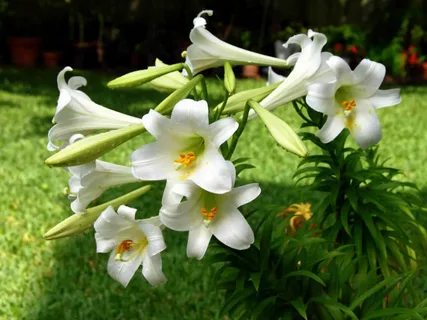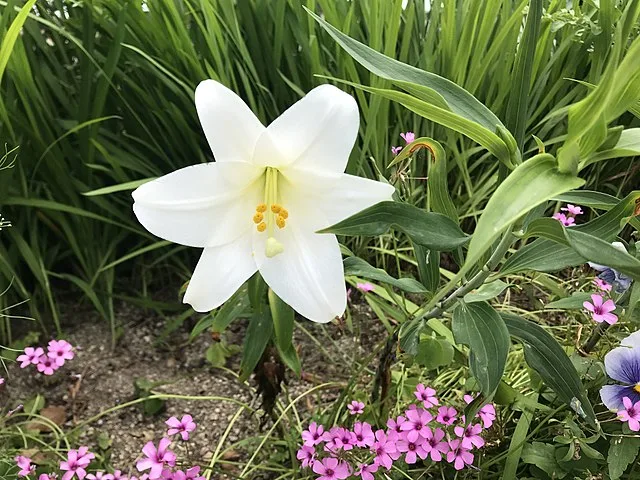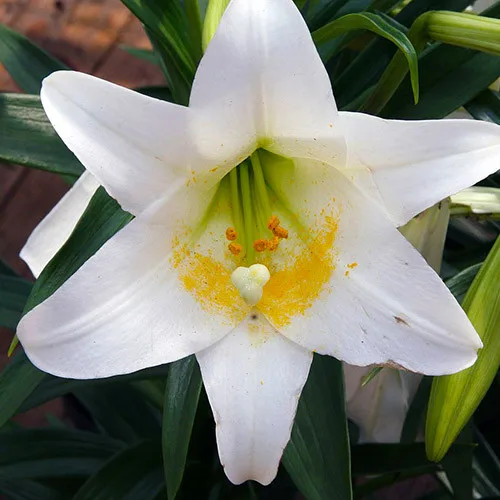Index
Presentation
The Trumpet Lily, scientifically known as Lilium longiflorum Thunb, are majestic and elegant flowers that dazzle with their beauty. Originally from Japan, these lilies are appreciated all over the world for their delicate shape, white petals and enchanting scent. Commonly grown in gardens and used in floral arrangements, Trumpet Lily represent purity, rebirth and hope.
Meaning of the Trumpet Lily
The term Trumpet Lily typically refers to a type of flower belonging to the Lilium genus. These lilies are characterized by their large, trumpet-shaped flowers that often bloom in vibrant colors such as white, yellow, pink, or orange. They are prized for their beauty and are commonly used in gardens and floral arrangements. The name “Trumpet Lily” is derived from the shape of the flower, which resembles a trumpet or horn. These lilies are known for their elegance and fragrance, making them popular choices for various occasions and settings
| Item | Information about the Trumpet Lily |
|---|---|
| Common Name | Trumpet Lily |
| Botanical Name | Lilium longiflorum Thunb |
| Family | Liliaceae |
| Plant Type | Herbaceous perennial |
| Adult size | Around 90 to 120 centimeters tall |
| Sun exposure | Full sun |
| Soil type | Fertile, well-drained |
| soil pH | Slightly acidic to neutral (pH 6.5 to 7.0) |
| Flowering time | Spring and summer |
| Flower color | White |
| Native Area | Japan |
| Toxicity | Toxic to cats, non-toxic to humans |

How to care for Trumpet Lily
The Trumpet Lily is a stunning flower that requires specific care to thrive. Here are some important tips to ensure that your plants grow healthy and lush:
Light
The Trumpet Lily prefers direct sunlight. Place the plants where they receive at least 6 hours of sunlight a day. However, avoid excessive exposure to strong sunlight during the hottest hours of the day, as this can damage the flowers.
Soil
Make sure you plant the Trumpet Lily in fertile, well-drained soil. Add organic matter, such as compost, to improve the quality of the soil and ensure good drainage.
Water
Water Trumpet Lily lilies regularly, keeping the soil moist but not soggy. Avoid watering the leaves to prevent the development of fungal diseases. During the warmer months, it may be necessary to increase the frequency of watering.
Temperature and humidity
The Trumpet Lily thrives in moderate climates, with temperatures between 18°C and 24°C. Maintain a moderate relative humidity around the plants, avoiding very dry environments.
Fertilizing
Fertilize Trumpet Lily lilies during spring and summer using a balanced fertilizer formulated for flowering plants. Follow the fertilizer’s dosage instructions and avoid overdoing it, as this can harm the plants.

How to Make Trumpet Lily Cuttings
If you want to propagate your own Trumpet Lily, follow these simple steps to make healthy cuttings:
How to Make Trumpet Lily Cuttings
1.Choose a healthy bulb: Select a large, healthy bulb to make the seedling. Make sure the bulb has at least three scales.
2. Remove the scales: Carefully remove the outer scales from the bulb, leaving the inner scales intact.
3. Prepare the substrate: Fill a container with a light, well-drained substrate, such as a mixture of peat and perlite.
4. Plant the scales: Bury the bulb’s scales in the substrate, leaving the top exposed.
5. Keep the substrate moist: Water the planted scales and keep the substrate slightly damp, but not soggy.
6. Provide light and warmth: Place the container in a place with indirect light and a stable temperature between 18°C and 24°C.
7. Wait for growth: Over time, the planted scales will develop roots and shoots.
8. Transplant the seedlings: When the seedlings are big enough, transplant them into their own containers or into the garden.

How to plant the Trumpet Lily
When planting Trumpet Lilies in the garden, follow these guidelines to ensure success:
Site Selection
Select a sunny spot with fertile, well-drained soil. Avoid areas subject to waterlogging, as this can cause root rot.
Preparing the soil
Before planting, prepare the soil by adding organic compost to improve fertility and drainage. Make sure to remove any stones or debris from the soil.
Planting the bulbs
Plant the lily bulbs at a depth of around 15 centimeters, spacing them approximately 20 centimeters apart. Place the bulbs tip-side up and cover them with loose soil.
Watering
Water the newly planted bulbs to establish moisture in the soil. Continue watering as necessary to keep the soil slightly damp during the active growth period.
Pest and disease protection
Monitor the lilies regularly for signs of pests or diseases, such as aphids or fungi. Take preventative measures, such as applying natural insecticides and fungicides, as necessary.
Maintenance
Remove wilted flowers and dead leaves regularly to promote healthy growth and encourage continuous flowering. Provide support for the flower stalks as necessary.
Common Pests and Diseases of the Trumpet Lily
Here are some of the most common pests and diseases that can affect Trumpet Lilies:
- Aphids: Small insects that feed on plant sap, causing damage to leaves and shoots.
- Thrips: Tiny insects that feed on the leaves, causing silvery spots and deformities.
- Snails and slugs: Pests that feed on leaves and flowers, leaving a slimy trail and causing aesthetic damage.
- Botrytis (gray mold): A fungus that can cause dark spots on leaves and flowers, as well as rot.
- Root rot: Caused by excess moisture in the soil, leading to root rot and death of the plant.
Common Problems and Their Solutions
Here are some solutions for dealing with the common problems faced by Trumpet Lilies:
Aphids
Solution: Wash the plants with pressurized water to remove the aphids. If necessary, apply natural insecticides, such as neem oil, or use insecticidal soap.
Thrips
Solution: Remove and discard the affected leaves. Apply thrips-specific insecticides, following the manufacturer’s instructions.
Snails and slugs
Solution: Use physical barriers, such as crushed eggshells or copper rings, to protect the plants. It is also possible to attract snails and slugs using baits and then remove them manually.
Botrytis (Grey mold)
Solution: Remove the affected parts of the plant and discard them. Apply copper-based fungicides to control the spread of the fungus.
Root rot
Solution: Improve soil drainage by adding organic matter and avoid overwatering. Transplant affected plants to better-drained soil if necessary.

Curiosities and myths about the Trumpet Lily
Trumpet Lilies are fascinating flowers that have aroused curiosity and generated various myths throughout the ages. Here are some interesting facts and myths surrounding these beautiful flowers:
Curiosities
- Japanese origin: Trumpet Lilies originated in Japan, where they are known as “Sukashi-Yuri” or “Yuri”, and are highly valued in Japanese culture.
- Easter flowers: These flowers are often associated with Easter, representing purity and spiritual renewal.
- Use in Traditional Medicine: In some cultures, parts of the plant are used in traditional medicine to treat various health problems.
- Hybrid Varieties: There are numerous hybrid varieties of Trumpet Lily, with different colors and flower shapes, created by horticulturists all over the world.
Myths
- Bad Omens: In some cultures, there is a myth that receiving Trumpet Lilies as a gift can bring bad luck, especially for newlywed couples.
- Protection against nightmares: On the other hand, some believe that keeping Trumpet Lilies in the bedroom can protect against nightmares and negative energies.
These curiosities and myths add a layer of fascination and mystery to Trumpet Lilies, making them even more intriguing for those who grow and appreciate them.
Conclusion
After exploring the care, curiosities and myths surrounding Trumpet Lilies, it’s clear to see how these flowers are not only beautiful, but also full of meaning and history. Learning about their specific cultivation needs, from sun exposure to proper watering, allows gardeners to fully enjoy the beauty of these plants in their gardens and floral arrangements.
What’s more, by uncovering the curiosities and myths surrounding Saint-Joseph lilies, we are taken on a cultural and symbolic journey that enriches our understanding and appreciation of these flowers. Whether as a symbol of purity and renewal, or as the protagonists of legends and superstitions, Trumpet Lilies continue to enchant and inspire people all over the world, providing a special link between nature and humanity.
Frequently Asked Questions
What color is Trumpet Lily?
The Trumpet Lily usually has white flowers, symbolizing purity and spiritual renewal. This shade is predominant in many varieties of the plant, although some hybrids may have slightly different shades, such as cream or yellow.
What does Trumpet Lily look like?
Trumpet Lily is an upright herbaceous perennial with elongated green foliage and majestic trumpet-shaped flowers. Its white flowers exude a soft, pleasant scent, while its long, narrow leaves add a touch of elegance to the garden. This plant usually reaches a height of around 90 to 120 centimeters when mature, and is appreciated both for its ornamental beauty and its symbolic significance in various cultures.







